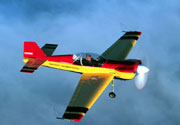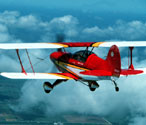Applying for an aerobatic practice box or contest box waiver? You’ll need to apply through your local Flight Service District Office (FSDO) for an FAA Form 7711 Certificate of Waiver or Authorization. Guidelines for your contest box can be found at: Aerobatic Contest Box: 8900.1 Vol. 3, Ch6, Sec 5: Issue of a Certificate of Waiver for an Aerobatic Contest Box
While there are many places you can practice your aerobatics without needing any specific authorization from the FAA, if you plan to practice your aerobatics at altitudes below 1,500 feet, within 4 miles from the centerline of an airway, or within the surface areas (meaning that airspace segment that actually touches the ground) of Class B, C, D, or E airspace designated for an airport then additional approvals are required from the FAA. Specifically, you'll first need to apply for an Aerobatic Practice Area (APA), which provides FAA-sanctioned waivers of certain regulations to allow you to practice legally. APAs are issued all the time, either as "boxes" that are approved for up to 36 months at a time, or as temporary boxes of less than 10 days in length and used to practice for airshows and/or to conduct aerobatic contests. This document contains guidance for creating and maintaining an FAA waivered Aerobatic Practice Area (APA).
To acquire an APA, you should take the following steps:
1) Review: Aerobatic Practice Area: 8900.1, Vol.3, Ch6, Sec 4: Issue of a Certificate of Waiver for an Aerobatic Practice Area
8900.1 All forms are located in the Dynamic Regulatory System (DRS) at drs.faa.gov
This is the guidance that the FAA will be using as it decides whether to grant your waiver application or not. Where problems occur is when applicants request waivers that are inconsistent with the guidelines established in these documents, so you'll want to ensure you are complying with this guidance.
2) Complete FAA Form 7711-2. The key is to only complete the front side, as the back side is only relevant for airshows and air races, and then sign the bottom of the back page. You'll need to define the specific FARs that you want to have waived, and you'll need to attach a picture of the requested APA. Google Earth or Google Maps is a very good way to get such a picture, and to show the dimensions of the airspace you're referencing.
3) Complete the basic information in the Environmental Information Document (EID). (This form not needed for a contest box.) You don't need to send letters to the various agencies described in the document, but you do need to provide as much information as you can. The FAA's Environmental Specialist will take this document and complete all the steps necessary to comply with EPA requirements. NOTE: This process can take up to 90 days to complete so plan for this accordingly. Also note that this step is only required for APAs of duration greater than 10 days. For a local contest, this step is not required.
4) Although not required, it is often helpful to get support from the airport manager if you're flying at an airport, or from landowners beneath the requested APA if you're flying away from an airport. Opposition from these parties can't stop a waiver from being issued, but it can slow the process down. Gaining their support is always helpful and can often help you to craft your application in a manner that meets your needs while also showing support for the FAA's desire for all aircraft operators to comply with "good neighbor" policies.
5) Once complete, you should submit in triplicate your Form 7711-2, attached drawings/pictures of the requested APA location, the EID, and any supporting materials you have to the local FAA Flight Standards District Office (FSDO).
It's important to note when completing these applications that the more complex the area is that you're trying to fly in, the more creative you'll need to be to help the FAA in ensuring compliance with all the regulations and guidelines. If there are houses nearby, or you're applying for a waiver at a busy airport, or in a location that intersects with an instrument approach, or an arrival procedure for another large airport, or where there's a history of poor relations between the local airport and the community, the burden on the applicant to demonstrate compliance with the regulations, AND reasonable efforts being taken to mitigate your impact on the sources of concern, while also working to be a "good neighbor", will go a long way to accelerating the approval of your APA.
Regional IAC Government Relations Representatives are available to assist members in applying for and addressing any concerns regarding the establishment or renewal of an Aerobatic Practice Area.
In addition, as a division of EAA, IAC members have staff representation in Washington, D.C., and access to the EAA Government Relations Department who monitor the Federal Register daily and respond to changes that impact our members. Also, the EAA staff participates as members of the General Aviation Action Plan Coalition and the Air Rulemaking Advisory Committee as well as work with many other aviation organizations that may affect the future of aerobatic flight.
 |
 |
 |

